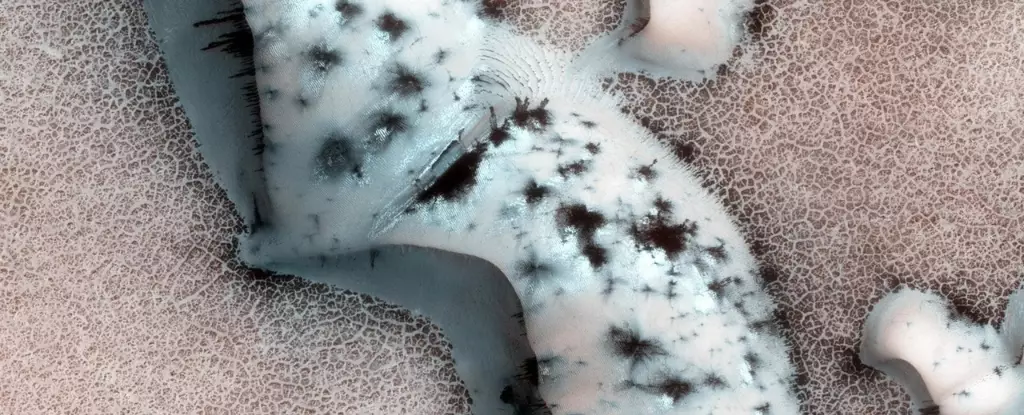Mars, often perceived as a barren and desolate planet, possesses an intrinsic beauty surprisingly unlike anything found on Earth. While humanity has long admired the lush landscapes and vibrant ecosystems of our home planet, the enigmatic features of Mars, particularly its seasonal carbon dioxide (CO2) geysers, prompt us to reconsider our understanding of beauty in the universe. Exploring these extraordinary phenomena offers insights not only into the Martian environment but also into the unique geological processes that differentiate our neighboring planet.
Mars is characterized by a thin atmosphere, predominantly composed of approximately 95% carbon dioxide. Unlike Earth, where a rich mixture of gases supports diverse life forms, the Martian atmosphere struggles to maintain warmth, especially during the planet’s harsh winters. In these frigid months, CO2 undergoes a fascinating transformation: it freezes and accumulates, creating a thick, dormant layer on the poles. This stark seasonality contributes to the planet’s dynamic visual landscape, challenging our notions of beauty and liveliness.
As the Martian winter gives way to spring, a peculiar interplay between temperature, sunlight, and geology comes into effect. When sunlight filters through the ice covering the CO2, it unexpectedly warms the ground beneath. This warming leads to a crucial process known as sublimation, where solid CO2 transitions to gas, building up pressure beneath the frozen layer. The intricate dance of temperature and state change reveals a beautifully chaotic relationship unique to Mars.
NASA’s Mars Reconnaissance Orbiter, equipped with the high-resolution Imaging Science Experiment (HiRISE) camera, has captured breathtaking images of these CO2 geysers, showcasing their majestic eruptions and the ensuing patterns they create. As pressure builds beneath the ice, the frozen CO2 layer can rupture, unleashing geysers that release gas and eject sand-sized grains at velocities reaching up to 160 km/h. These spectacular eruptions result in the formation of dark patches on the surface, which can span up to 1 km in diameter—a phenomena as beautiful as it is scientifically intriguing.
One of the most extraordinary outcomes of these eruptions is the formation of what scientists have termed “araneiform terrain,” or spider terrain. This intriguing morphology, reminiscent of intricate spider webs, manifests as clusters of dark spots and channels that weave across the icy landscapes, giving Mars a distinct and artistically complex appearance. Such geological features evoke a sense of wonder, showcasing nature’s creativity in ways previously unimagined.
The processes that explain the formation of Martian geysers have been meticulously studied, leading to the formulation of the Keiffer model. This theoretical framework posits that the seasonal ice cap creates an impermeable, translucent slab of CO2 ice. As sublimation occurs at the base, high-pressure gas accumulates beneath the slab, contributing to the eventual rupture and explosive release of gas through high-velocity CO2 vents. This model offers a scientific narrative to the awe-inspiring phenomena witnessed on the Martian surface, blending artistry and science to enrich our understanding of our planetary neighbor.
While Earth has been exalted through generations of poetry and artistic expression for its vibrant ecosystems and breathtaking landscapes, Mars extends an invitation to appreciate beauty beyond familiar boundaries. The stunning geysers and spider terrain of Mars exemplify a geological splendor that defies earthly comparisons. They remind us that beauty is not confined to lush greenery and colorful blooms but can also be found in the starkness of frozen CO2 eruptions and unique formations shaped by extraterrestrial processes.
The interplay of climate, geology, and atmospheric dynamics on Mars gives rise to astonishing features that challenge our perceptions of beauty and nature. As we delve deeper into the Martian landscape, we may find joy in its differences, celebrating a realm where the beauty of the desolate contrasts with the vibrancy that we hold dear on Earth. The exploration of Martian geysers not only broadens our understanding of planetary processes but also deepens our appreciation of the aesthetic wonders the universe has to offer.


Leave a Reply